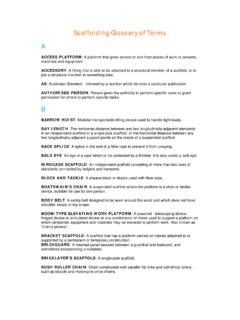Transcription of Scaffold Specification Template - Safety & Access
1 Scaffold Specification Template _____ Issue Date: 22nd March 2012 Page 1 of 16 Scaffold Specification Template (Guide to Managing and Appointing Scaffolding Contractors) Management Guide NASC/UKCG Guidance 22nd March 2012 Scaffold Specification Template _____ Issue Date.
2 22nd March 2012 Page 2 of 16 The demand for this guidance is a signal that industry wishes to only use scaffolding contractors that work to the latest guidance and procedures. The UKCG s support of this guidance will hopefully accelerate the adoption of this protocol across all corners of the construction sector to ensure that scaffolding is always to the safest of standards Rob Lynch, NASC President UKCG s aim is to provide a world class standard of best practice for UK construction and we are proud to co-brand this guidance from the NASC s as it complements our objectives perfectly.
3 We recognise that NASC sets the standards for scaffolding in the UK and this guidance makes sound logical sense for all construction contractors to adhere to. Stephen Ratcliffe, UKCG DirectorScaffold Specification Template _____ Issue Date: 22nd March 2012 Page 3 of 16 Published by: National Access & Scaffolding Confederation Email: Website: NASC 2011 First published 2011 This guide has been prepared by the National Access and Scaffolding Confederation (NASC) Scaffold Specification Working Group to improve the quality of the Scaffold structures erected on construction sites and other works of engineering maintenance and within accordance with current legislation, guidance and protocol and in turn minimise the risk of accident or injury to operatives working on or near the Scaffold and the general public.
4 This document is intended for use by any undertaking that has responsibility for the management, use, monitoring and provision of scaffolding. This document is formatted in a Template style that will allow such businesses to easily adopt this format. We recognise that some businesses may have their own preferred method for distribution of the content and as such this document is deliberately in an editable format to allow for local variations of distribution, hard copy, digital, on line software etc. The guide has been written on the assumption that the execution of its provisions is entrusted to appropriately qualified and experienced people and that construction and supervision of scaffolds will be carried out by capable and experienced organisations.
5 NASC shall be under no liability of whatsoever kind however caused whether or not due to the negligence or wilful default of NASC or their servants or agents arising out of or in connection with this document or any part thereof. Amendments issued since publication Amd. No. 1 | | Comments: Additional UKCG branding added Amd. No. 2 | | Clause Proof load corrected to to comply with TG4:11 Scaffold Specification Template _____ Issue Date: 22nd March 2012 Page 4 of 16 Contents Page No.
6 1. APPLICATION 5 Tube & Fitting Scaffolding 5 System Scaffolding 5 Lightweight Mobile Tower 5 2. REGULATIONS, CODES OF PRACTICE & BEST PRACTICE 6 3. COMPETENCE 6 Scaffolding Companies 6 Scaffolding Operatives 7 Scaffolding Labourer 7 Trainee Scaffolder 7 Scaffolder 7 Advanced Scaffolder 8 4. SCAFFOLDERS Safety AND PPE 9 5. SCAFFOLDING DESIGN 9 6. MINIMUM Scaffold REQUIREMENTS 10 Scaffold Tube 10 Scaffold Boards 10 Scaffold Fittings 10 Brick guards, Sheeting and Debris Netting 10 Loading Bays 10 Access /Egress to Scaffolds 11 Internal Edge Protection 11 Scaffold Ties 11 Hop Up/Stage Brackets 12 7.
7 Scaffold HANDOVERS AND STATUTORY INSPECTIONS 12 8. RISK ASSESSMENTS AND METHOD STATEMENTS 13 Appendix A NASC guidance listing referred to within this document 14 Appendix B Example of CISRS Scaffolders cards 15 Appendix C Scaffold Inspection Report Sheet 16 Scaffold Specification Template _____ Issue Date: 22nd March 2012 Page 5 of 16 1. APPLICATION This Specification identifies the minimum requirements and standards for all scaffolding and edge protection designed, erected, altered, inspected, used and/or dismantled.
8 This Specification may be enhanced by an individual company s specific scaffolding policy and branding. Hoists, Ladders, Stepladders and Podium Steps are not included as part of this standard. Tube and Fitting Scaffolding This applies to traditional steel tube and fitting scaffolds and includes the use of system type components such as Readylok or Easifix transoms , extending transoms, steel and aluminium ladder beams and unit beams. All such components must be used in strict accordance with the manufacturer s instructions/design guidance, and the information supplied to site upon request. System Scaffolding All types/brands of Systems Scaffolding used on site must conform to the relevant British and European Standards BS EN 12810/12811.
9 The lead hand of a Scaffold gang using systems scaffolding must have successfully completed the relevant CISRS Systems product training. CISRS Scaffolders or Trainee operatives will be able, as a member of this squad to erect, alter or dismantle this equipment under the direct supervision of the CISRS systems qualified operative prior to them carrying out the requisite CISRS training. See for the current list. Lightweight Mobile Tower A nominated person is permitted to erect, inspect, use, move, alter and/or dismantle a lightweight Mobile Tower if they are competent and hold a recognised qualification specifically includes mobile towers.
10 Mobile towers must be inspected as often as is necessary to ensure Safety . Recommended best practice is that they be inspected and a report made by a competent person after assembly, or significant alteration, and before use. Thereafter, they should be inspected as often as necessary but at least every 7 days, or after any event likely to have affected stability or structural integrity, such as adverse weather conditions. But, there is no need to inspect and report every time the mobile tower is moved at the same location. Scaffold Specification Template _____ Issue Date: 22nd March 2012 Page 6 of 16 Note: Refer to relevant industry association - Prefabricated Access Suppliers & Manufacturers Association (PASMA) website for more information.




